Back in 2019, Guy Williams explained to us about the work of Weta FX on Gemini Man. He then worked on Lady and the Tramp, The Suicide Squad, Peacemaker, The Batman and She-Hulk: Attorney at Law.
After telling us about his work on Alita: Battle Angel in 2019, Mike Cozens has worked on many projects such as Lady and the Trame, The Suicide Squad, The Green Knight, Peacemaker and She-Hulk: Attorney at Law.
How did you and Weta FX get involved in this film?
Guy Williams (GW): We were lucky enough to have worked on James’ previous two projects (The Suicide Squad and Peacemaker) as well as the last Guardians film. We have grown into a good understanding of what James wants and needs and were able to just roll right into this one.
How did it feel to be back into the Guardians of the Galaxy universe?
GW: James is a brilliant writer as well as a brilliant director. We were all in. He writes the kinda stuff that we love to work on.
Mike Cozens (MC): As Guy mentioned, Weta FX has been working with Marvel for many years. Guy and I were both very excited to be involved in his final Guardians film. We knew James was going to be looking for engaging character performances and wildly epic visual effects shots. It was a big, exciting challenge.
How was this new collaboration with Director James Gunn and VFX Supervisor Stephane Ceretti?
GW: This was my first time working with Stef directly (we were both on X-Men First Class, but our paths never crossed). I really enjoyed getting to work with Stef. He has a fun energy and an even more amazing eye.
MC: We love working with James. He is a director that understands visual effects and is engaged through the entire production. He has an extremely sharp mind and a collaborative approach to his character and world building. His hands-on approach means he is acting out bits of performance in every meeting. His sense of humour makes the whole experience a real pleasure. Stef is a force of nature and I really enjoyed working with him. The visual effects work on this film was a beast to wrangle and through the whole project he made the process smooth. He is collaborative, funny, thoughtful, and kind. We couldn’t ask for a better team to work with.
What were their expectations and approach about the visual effects?
GW: This was the final installment for the franchise, so expectations were naturally high. We knew that this show would be special and we were excited to support James’ vision for the last look at our Guardians. Stef and team approached the project by planning early, which we really appreciated – they turned over assets to us very early on so we could get an early march on the show. This was key.
How did you organize the work with your VFX Producer?
GW: We looked at the block of work that they wanted to pass to us and started by identifying the major challenges. For us, this was the scope of the FX work, the Arête (and all of the types of destruction it had to be a part of) and lastly the one-er. On day one, we started building our plan and assets to serve the challenges. We also got right into the one-er with Anim (even before the assets were ready) so that we could start sorting out the timing that would drive everything.
What was the work made by Weta FX?
GW: We mostly worked on the action sequences in the third act (which also featured some excellent work from Framestore). We did all of the shots of the Arête as seen from outside, including when it lifts out of the harbour in Counter-Earth, with Quill, Groot, and Theel falling out of the top and past it as it lifts out. We worked on the entire space battle, from the arrival of the Bowie to the Arête, to the Arête’s final destruction. We also did the Abilisk shots, the fight on the command deck with Quill and Groot, the team assemble scene in the spaceport, and the giant one-er. That is just a cross section of the work we did. All told, Weta delivered just over 600 shots.
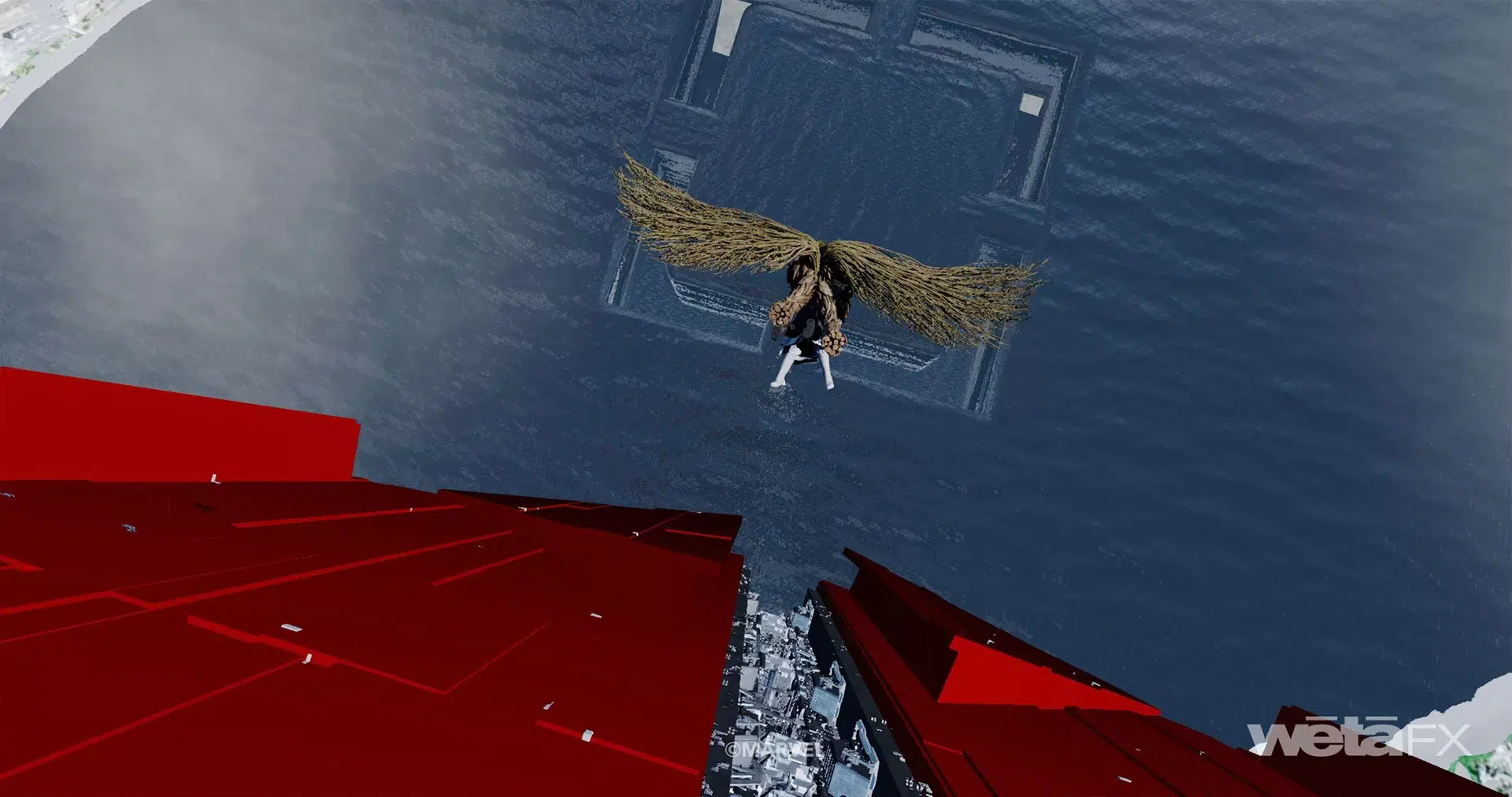
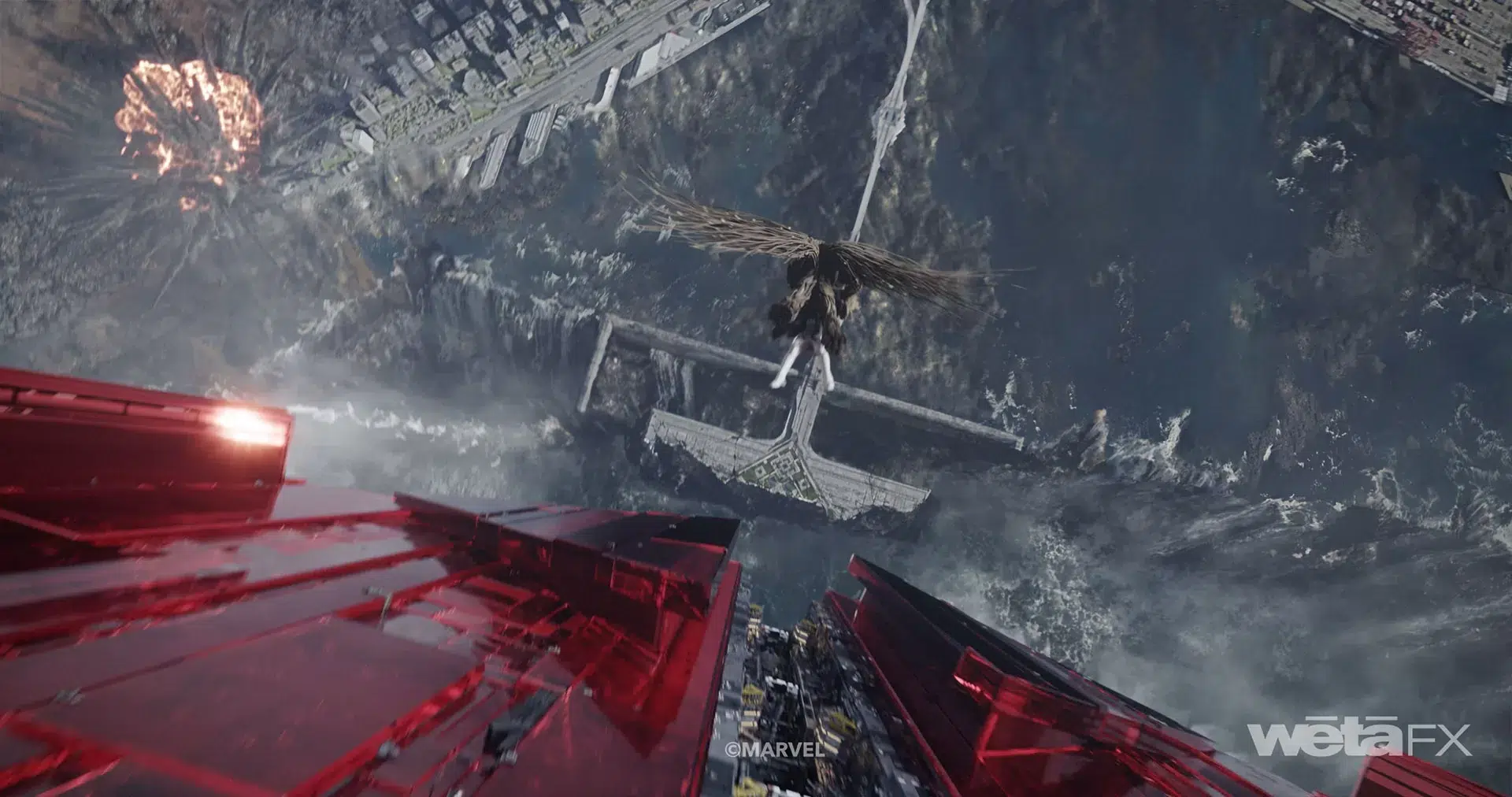
How did you work with the art department to design The Arête?
GW: We started with a great set of artwork from the production side art department. We used these and worked with our art department to add some detail and flesh out the design. From there, we went into the build and solved the rest of the look during the process.
Can you elaborate about the creation of this huge spaceship?
GW: I can try ? First, a little context… The Arête is a giant spaceship that is 3 kilometres across. We start on it buried in the harbour of Counter-Earth (we initially think it is just a 200 metre tall building). It then lifts out of the ground, destroying a large portion of the city and harbour. We then catch back up with it in space for the space battle where it ends up getting destroyed.
We started by using a simple model to understand the motion requirements and later, the destruction requirements. We then bent a city-builder to our needs. We took the simple model and used various rulesets to break up the surface then instance detail onto the surface. Different regions defined the assets instanced and the amount of detail included – areas that looked more industrial had more depth and layers, and areas under the red glass had detail but they had to be flatter to the surface, so as not to collide with the glass. The instancer didn’t just run once, we used it to build layers. Another part of the system took the simplified glass shell and broke it into many more surfaces. Scale is always an issue with such a large ship – in the absence of known references, we had to rely on detail and complexity to guide the impression of scale. Each of these new plates of glass had complex extrusions coming out of the back surfaces to help break up the refractions of what was underneath. Then yet another instancer added detail on top of the glass in the form of bracket like structures, equipment complexes, and antennae. This is all before we even get into shading the Arete. The metal surfaces were pretty straight forward, but the red glass ended being more like a ruby to get an even richer red result. We had to create a cheat to reduce total internal reflection (large black patches started showing up in the glass, which is correct but undesired). We tried to cheat the IOR to fix this but that didn’t pan out, so we roughened some of the surfaces on the edges and that cleaned it up without sacrificing the shiny highlights on the visible faces.
As we are doing all of this, we had to keep in constant communication with the FX team to make sure they could still work with the model for the multitude of destruction shots headed their way. They had to de-instance areas of destruction so they could do a sim on it. They would then pass that info o back to the lighters so they could turn those parts off in the base model for their renders. We solved this by working closely with Anim to lock down as much as we could so this complex work wouldn’t end up getting unwound if tweaks were made in the future.
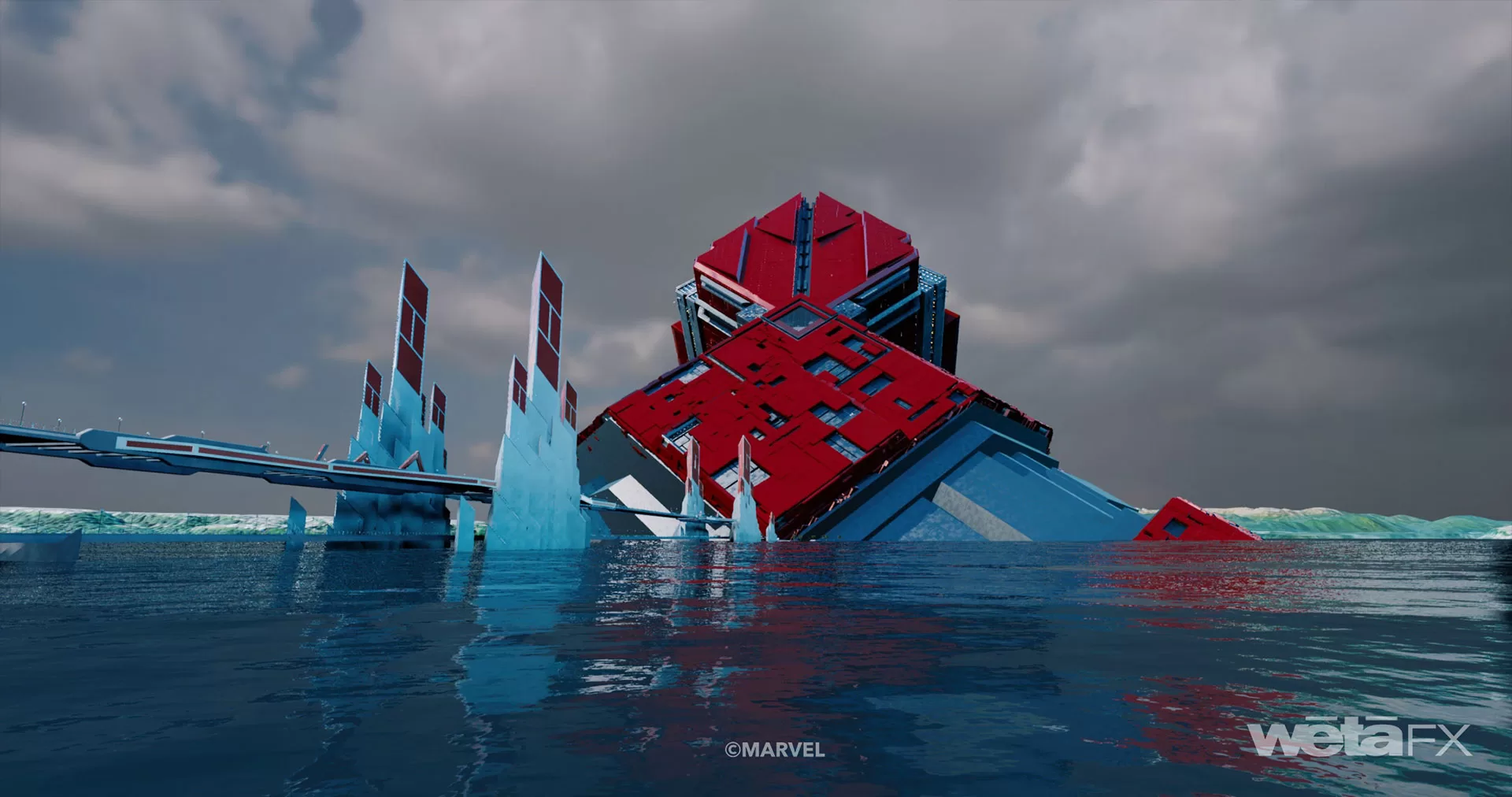
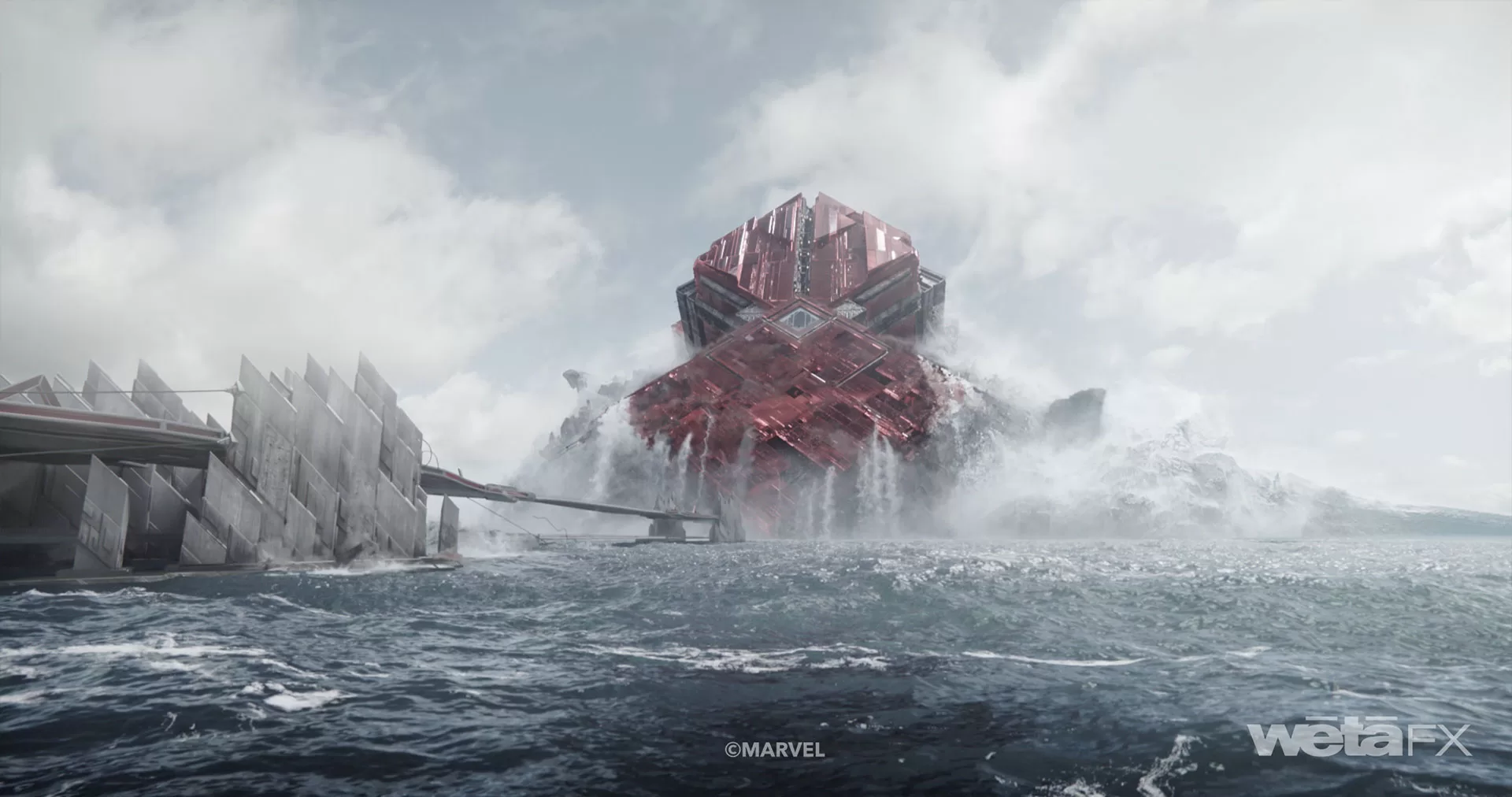
How did you handle the challenges of the Arête’s massive size?
GW: If you know what you are up against, then everything from that point on can be guided by the principle. We knew scale was a major challenge, so we went with a complex instancing system to give it a sense of scale, adding lights (like windows) all over the surface to help define scale, and added indistinct machinery that also gave an impression of scale. On top of all of this was Animation and FX – their work all reinforced scale.
How did you create and destroy the city and planet behind the spaceship?
GW: Stef did an aerial shoot of Seattle for this sequence, and while we didn’t end up using the plates because the cameras ended up getting redesigned, they served as perfect reference for what we wanted the result to look like. Our Matte Painting team did a fantastic job of building the city. They used various data sets to get starting models for the terrain, buildings, and roads. They then used Clarisse to populate the city with trees and terrain details. On top of this, they painted in extra detail to make it even more realistic.
Knowing the city was to be destroyed, they set it up so they could paint a region mask and the buildings would decay into more and more destroyed versions of themselves. This allowed us to later lay waste to large parts of the city without having to build it all over again.
For the destruction of the city, in background shots, we used mostly matte painting destruction. The FX team did some huge explosion sims that layout would dress into shots. From there, matte painting would paint in more detail at the bases of the explosions (like large fires and craters). Matte painting also dressed in some pre-canned FX sims for large scale smoke plumes. There were two very bespoke shots of the Bowie escaping the city as it blows up all around the ship. These were done as traditional full builds in the foreground with FX work and destruction. We then padded out the background destruction as above to create a continuous sense of destruction. These two shots had many layers of FX destruction: buildings breaking up and collapsing, large explosions, lava spewing up from the cracks in the earth, debris being thrown into the air. These two shots were in production for a very long time to make sure that they had all of the right parts to sell the intensity and freneticism of the action.
Let’s talk about the creatures work and especially Rocket and Groot. How did you enhance your assets?
GW: There wasn’t too much we could do as the assets were shared, and plus, we have seen the characters so much before, we love who they are. The main place we meddled with the formula was Groot. He is always doing something that changes his base model, like Octo Groot in the command deck fight, where he grows eight extra arms. These had to be planned with animation and built in a way that was flexible.
Groot is now bigger and stronger. How did that affect your animation work?
MC: James described Groot as “The college-aged, football-playing Groot. He is always happy and always ready to go.” He is a happy-go-lucky character but tough as nails. He has multiple different states in the film: he has weapons hidden in his body, he grows Octo-arms, has a protective shield for Quill, has wings, has big tentacle arms to dispatch Hellspawn in the hallway fight, and then has branching arms as he attempts to save Quill in space. All of these different character states needed to be designed to function for animators. The puppets needed to be fast, poseable and accurate. These states also needed to work for the Creature pipeline, where they added smaller levels of animated detail.
Groot’s performance required choreography that worked with the photography. We match-moved all the actor’s performances in the photography and loaded that into the capture session so that the Weta Groot actor could see the performance he is working to. We also have the tracked camera on the capture stage so we can see the shot developing in real time. Weta’s Groot performer was Ike Hammon, a New Zealand Stunt Coordinator. He balanced James’ intention for the character’s performance with the physical choreography. Because Groot is bigger and stronger, we often needed to rework the capture in animation to amplify the weight and polish the performance.
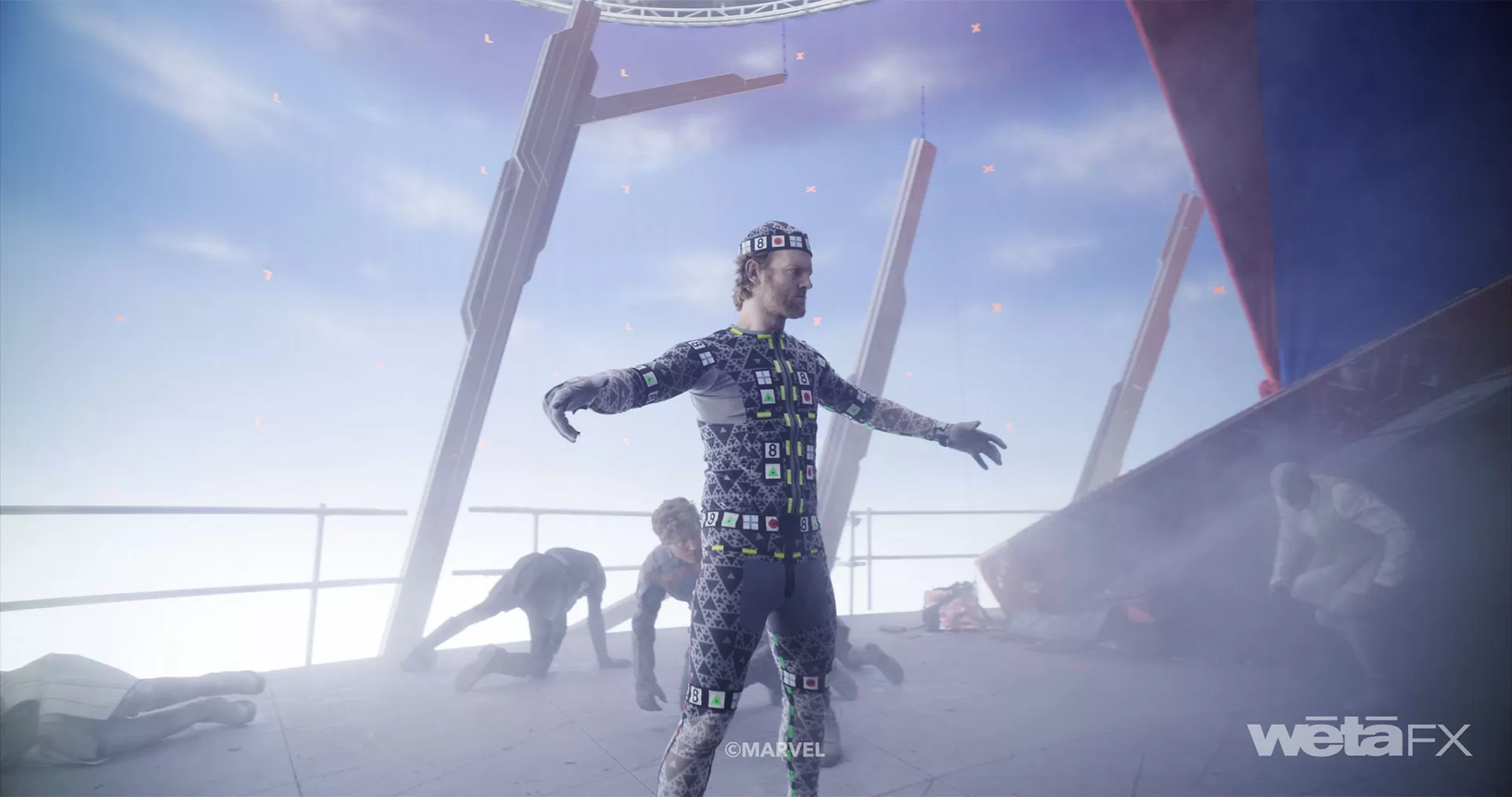
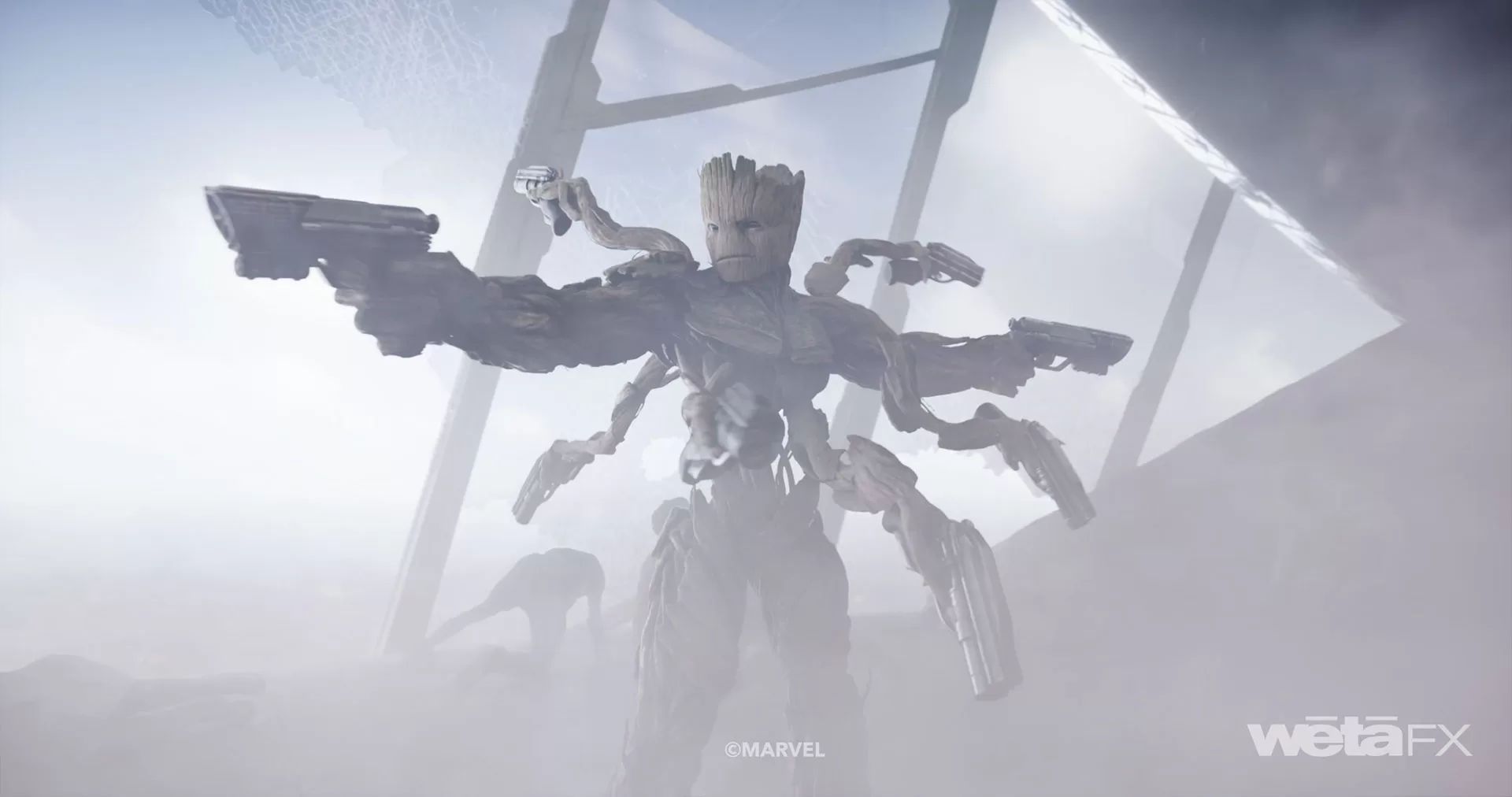
The Abilisks are back. Can you elaborate about their creation and animation?
GW: For their creation, we see three of them instead of the one healthy one from the second Guardians film. We added a slight sense of mole rat (for lack of a better term) to them to show that they were prisoners trapped in a dark environment for a long time. We also created two extra variants in color and patterning to help delineate them.
MC: James wanted the Abilisk scene to feel like a horror film. We start the scene with just Nebula’s flashlight lighting the shots. We used Weta’s Gazebo system to light the animation work and create timings for the reveal of the creatures. The Abilisks needed to move quickly as they pursue the characters, so we developed a walk and a run for these enormous creatures using walrus motion as reference.
There is an impressive oner during the third act. How did you approach a complex shot like that?
GW: Planning and discussions, with some more planning thrown in for good measure! There were 18 shots that had to be stitched together, the plates were shot at 120fps and all of it had to be timed to a music track. This one shot (or 18, depending on how you look at it) took almost a year and a half to do. All of the digital stitches were hard, but the main challenge was that any change to the timing affected all of the shots, so, as stated above… planning was key. Mike and his team did an amazing job sorting a lot of the timing issues out.
MC: Thanks Guy. The hallway fight was one of the larger challenges on this project. As the Guardians head into the ship to free the children, we have a two-minute single shot to the tune of “No Sleep Till Brooklyn” by the Beastie Boys. James wanted the choreography to hit the rhythm of the music, and he had us watch Jeong Byeong-gil’s “The Villainess” to understand the type of camera operation and energy he was chasing. This work required a lot of pre-planning with a small team to pull it together properly.
Can you explain in detail about its shooting and your work on it?
GW: In under 20 pages of text, not really. This one shot was a ton of work. It had face replacements all the way up to full CG takeovers (with hero characters large in frame). Let me give you a ‘for instance’…
There is a moment where Mantis vaults off from Groot’s arm and lands on the shoulders of one of the guards. The first part of the action had one stunt rig for Mantis’ vault and the second part (a different shot) had a rig for the guard’s back flip. The cut happened as Mantis lands on the shoulders, both of their faces large in frame. We had to replace both of them with digital doubles. They had to hold up perfectly close to camera or the moment would have been cheapened and the audience would have dropped out of the oner right at the start. There were a lot of moments like that in the oner to solve.
MC: Wayne Dalglish, the Stunt Coordinator, had developed stunt-vis that informed James, Stef, and the shoot. The vis was done to the music and hit different beats in the song. The Weta Previs team built a pass as quickly as possible to help James, Stef and Fred Raskin decide how the performance beats and choreography might work. In postvis we created a visual metronome to tie different CG elements to the music. We used motion vignettes, hero keyframe animation, and performance capture to build the scenes. As the choreography was approved, we rebuilt the animation for the final product. Some of the more complex rig work on the characters was in development in parallel with the animation work.
The solid onset work done by Stef had most of the cut points already working, but due to the complexity of the stunts and construction of the scene, there were a handful of tricky stitches to do where the actors were right in frame at the cut point. Layout Lead Tim Civil built digital camera stitches – these had to be seamless, so the motion work was built from the match-moves of the actors and the characters went digital across the cut points.
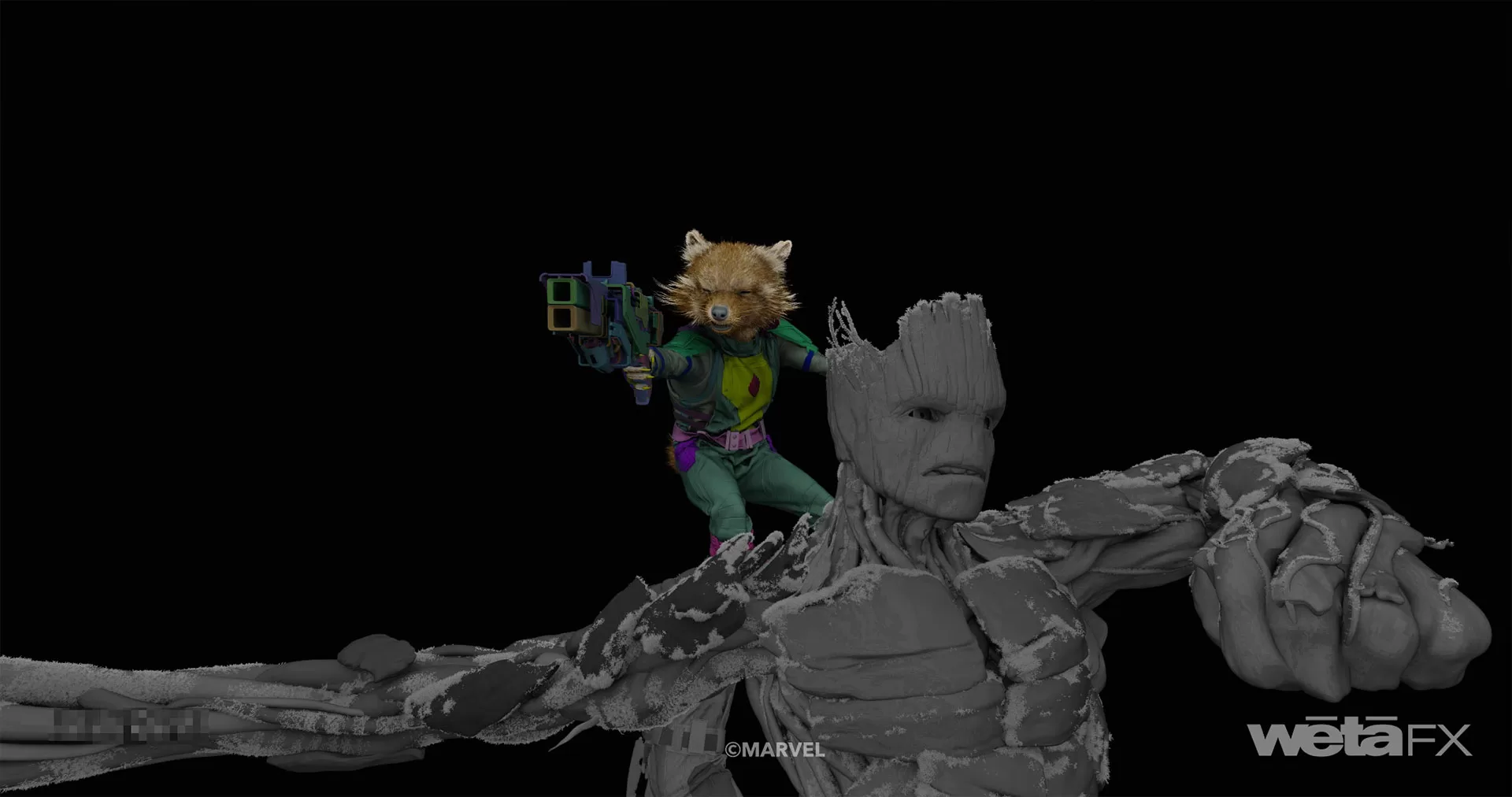
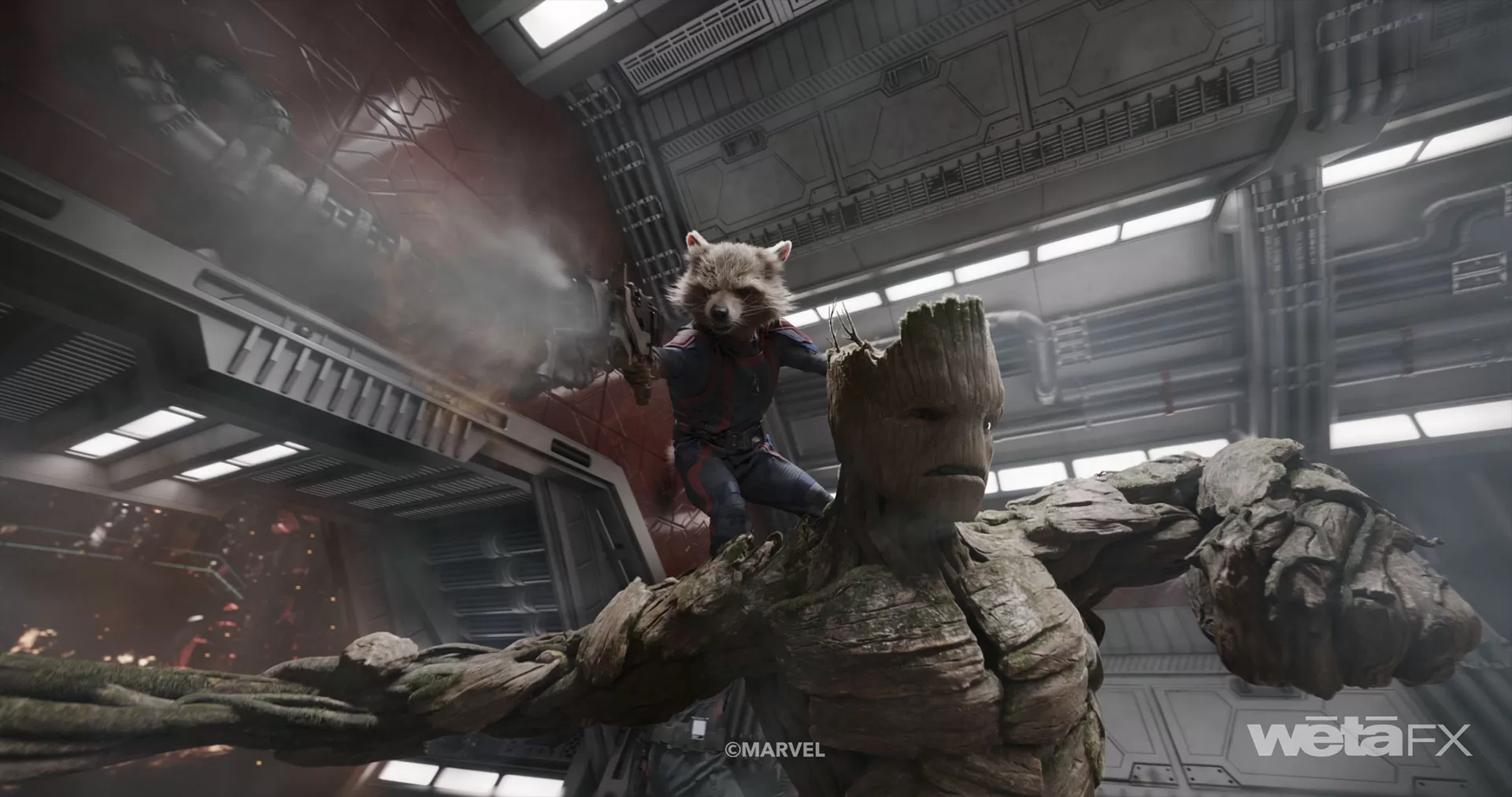
In addition to its complexity, the oner is seen in slow-motion. What’s the main challenge about it?
GW: Since it is all timed to the Beastie Boys song, any change in timing had to be accounted for somewhere else. It was shot in slow motion so that speed ramps for action could be sorted in post, which is a rather standard practice. But this made it challenging because if you added a frame or two to a speed ramp, you had to steal it back in timing before the next song cue that you wanted to hit. We talked this over with James and Fred (the editor) to make sure that we could all lock down the ramps as early as possible.
MC: As Guy mentioned, the scene was shot at 120 fps to give the editors flexibility with re-speeding the plate. To simplify animation, we had animators work in the re-sped space while we built the shots (if a shot went to slow motion then animators animated the slow motion). This meant that they could avoid constantly converting their work back and forth between re-sped time and real time. The shots needed to be output at 24 fps for Creatures and FX (tissue, cloth and sim). Once Anim was approved, we needed to convert from the re-sped space to real time. This meant we had three different time spaces: 120 fps (source), re-sped (cut time), and 24 fps (real time). We needed to move work back and forth through these different spaces. There was a fair bit of math! We also ran into complexities such as having to negotiate stitch points in sub frames, having Creature sims that needed to run through three or four stitches, and troubleshooting elements that were misaligned by less than a frame. Our Creature Supervisor Jonathan Dysart and Comp Supervisor Steve McGillen were incredible at providing solutions to the challenges of this shot.
Can you elaborates about the creation of the Hellspawn?
GW: So, the story has this idea that Evo is trying to create the perfect race of beings to populate the galaxy with. For his army, he created a creature that was brutal and loyal and grafted it to a machine, turning it into the perfect foot soldier for his army if needed.
The production art department came up with a crazy beautiful design for these ‘Crustaceans’. We received a nice art pack with a high res zBrush model to start from. We had to do a bit of work to make sure the creature had good mobility, so we split some of the shell into overlapping plates so he could move his head, and changed the hips to allow the legs to walk and fold into the pods. From there, we used our Art team to come up with some variants of coloration. The only other change we did was adding a sword variant for a gag in the big oner.
How did you handle the challenges of their animation with this mix of creature and cybernetic?
MC: The Hellspawn animation developed through keyframe motion vignettes. Starting with a simple walk and flight before moving into more complicated performance. The performance leaned into the partially mechanical nature of their design.
The final sequence is full of destructions and CG elements. How did you prevent your render farm from burning?
GW: There were lots of explosions and destruction with shiny metal and glass. I wish there was some super clever trick, but it was a lot of diligent work by the CG Supes on the show to optimise the renders so we could get it all through. We often gloss over the work these smart people do and this is just one facet (albeit a very important facet) of their day-to-day work.
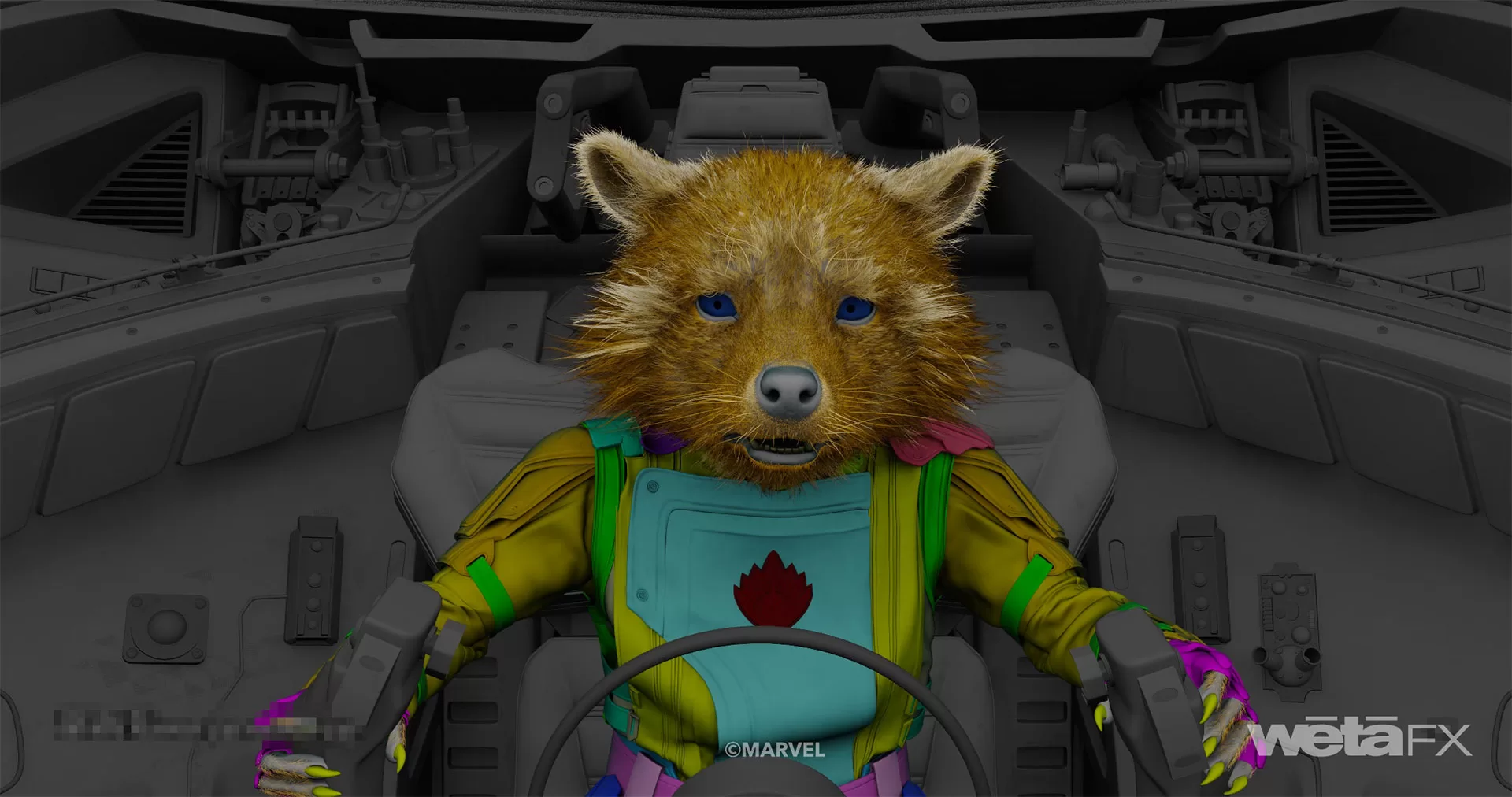
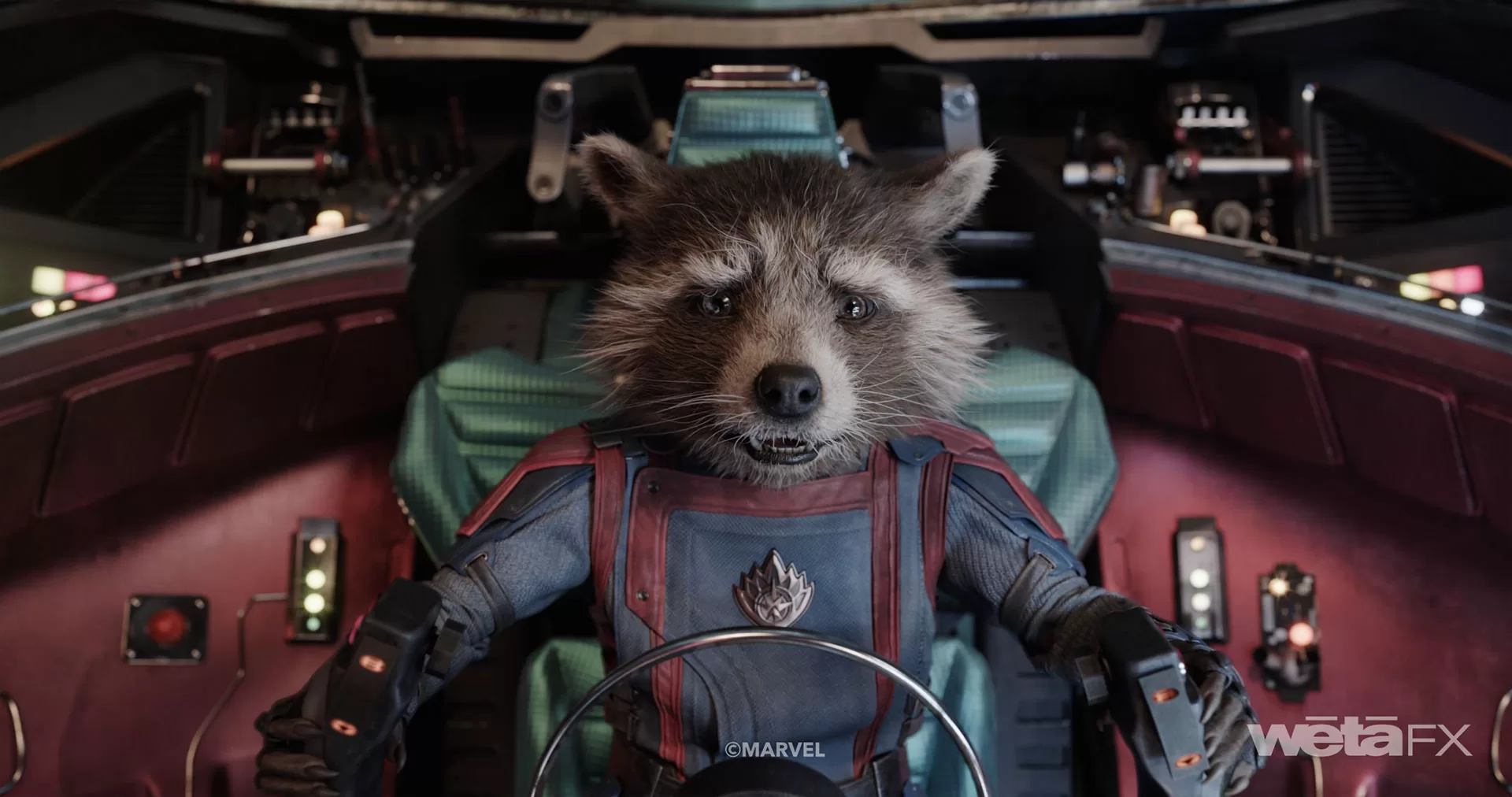
Which shot or sequence was the most challenging?
GW: It was either the oner, or when Quill runs through the burning ship as it crumbles around him… or maybe blowing up the entire planet as the Bowie tries to escape. It could have also been when the Arête lifts up out of the ground and the entire harbour pouring into the hole it was creating. One of those sequences for sure…
Was there something specific that gave you some really short nights?
GW: The sheer volume of FX work we had to do. Our FX department really came through and gave us a huge team of heavy hitters, but it was still daunting.
What is your favorite shot or sequence?
GW: It is like asking who your favourite child is… I love them all for different reasons.
What is your best memory on this show?
GW: Getting to work with the amazing team of artists here. Dailies was an experience of discovery every day. If you had something you thought would be impossible, someone had an excellent way to solve it that surprised and amazed me.
MC: I feel very fortunate working with James and Stef who have a high bar but make the challenge of the project a pleasure by being excellent people. My favourite memory of this show will be working with my Weta crew (artists and production) who, through many challenges, kept the pressure off by making me laugh. I could not ask for a better group of people to spend my day with.
How long did you work on this show?
GW: Just over a year and a half.
What’s the VFX shot count?
GW: Just over 600 shots.
What was the size of your team?
GW: It’s hard to say. The number changed all the time and some people were on the whole time, but others did shorter stints.
MC: The Animation Team grew to about 30 or 40 artists. Mark Smith and I split the Animation Supervision. We had Mariya Kalachova and Jonathan Paquin as our Anim Leads. Marco Spitoni and Tim Gaul created incredible Previs work. Excellent character performance and shot construction from Senior Animators Caz Ting, Ben Folkman, Tom Del Campo and Julia Chung. David Yabu as a Facial Lead and Marco Roeth as a Motion Edit Lead. Greg Wilton leading our Crowds crew. It was an excellent team!
What is your next project?
GW: Watch this space… ?
A big thanks for your time.
WANT TO KNOW MORE?
Weta FX: Dedicated page about Guardians of the Galaxy Vol. 3 on Weta FX website.
Stephane Ceretti: Here is my interview of Production VFX Supervisor Stephane Ceretti.
© Vincent Frei – The Art of VFX – 2023




